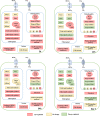Time-resolved transcriptome analysis of Scenedesmus obliquus HTB1 under 10% CO2 condition
- PMID: 35914242
- PMCID: PMC9871529
- DOI: 10.1111/1751-7915.14100
Time-resolved transcriptome analysis of Scenedesmus obliquus HTB1 under 10% CO2 condition
Abstract
Certain microalgal species can grow under high CO2 concentrations providing potential for mitigating CO2 pollution in flue gas produced by power plants. Microalga Scenedesmus obliquus strain HTB1 was isolated from the Chesapeake Bay and grow rapidly in a high level of CO2 . However, little is known about the molecular responses of HTB1 to high CO2 levels. Here, we investigated how HTB1 responds to 10% CO2 using the time-resolved transcriptome analysis. Gene expression profiles indicated that HTB1 responds quickly (in 2 h) and becomes adaptive within 12 h when exposed to 10% CO2 . Interestingly, certain genes of light-harvesting, chlorophyll synthesis and carbon fixation (i.e. rbcS) were up-regulated at 10% CO2 , and these functional responses are consistent with the increased photosynthesis efficiency and algal biomass under 10% CO2 . Nitrate assimilation was strongly enhanced, with amino acid biosynthesis and aminoacyl tRNA biosynthesis genes being markedly up-regulated, indicating that HTB1 actively takes up nitrogen and accelerates protein synthesis at 10% CO2 . Carbon metabolism including fatty acid biosynthesis and TCA cycle was enhanced at 10% CO2 , supporting the earlier observation of increased lipid content of Scenedesmus sp. under high CO2 levels. Interestingly, key genes like RuBisCO (rbcL) and carbonic anhydrase in carboxysomes did not respond actively to 10% CO2 , implying that exposure to 10% CO2 has little impact on the carbon concentrating mechanisms and CO2 fixation of the Calvin cycle. It appears that HTB1 can grow rapidly at 10% CO2 without significant metabolic changes in carbon fixation and ATP synthesis.
© 2022 The Authors. Microbial Biotechnology published by Society for Applied Microbiology and John Wiley & Sons Ltd.
Conflict of interest statement
All the authors declare that there are no conflicts of interest regarding this article.
Figures




Similar articles
-
Application of a microalga, Scenedesmus obliquus PF3, for the biological removal of nitric oxide (NO) and carbon dioxide.Environ Pollut. 2019 Sep;252(Pt A):344-351. doi: 10.1016/j.envpol.2019.05.084. Epub 2019 May 17. Environ Pollut. 2019. PMID: 31158663
-
Effects of different concentrations of CO2 on Scenedesmus obliquus to overcome sludge extract toxicity and accumulate biomass.Chemosphere. 2022 Oct;305:135514. doi: 10.1016/j.chemosphere.2022.135514. Epub 2022 Jul 4. Chemosphere. 2022. PMID: 35798159
-
Mixotrophic cultivation of a microalga Scenedesmus obliquus in municipal wastewater supplemented with food wastewater and flue gas CO2 for biomass production.J Environ Manage. 2015 Aug 15;159:115-120. doi: 10.1016/j.jenvman.2015.05.037. Epub 2015 Jun 7. J Environ Manage. 2015. PMID: 26063515
-
Modification and improvement of microalgae strains for strengthening CO2 fixation from coal-fired flue gas in power plants.Bioresour Technol. 2019 Nov;291:121850. doi: 10.1016/j.biortech.2019.121850. Epub 2019 Jul 20. Bioresour Technol. 2019. PMID: 31358426 Review.
-
Toxicity of tigecycline on the freshwater microalga Scenedesmus obliquus: Photosynthetic and transcriptional responses.Chemosphere. 2024 Feb;349:140885. doi: 10.1016/j.chemosphere.2023.140885. Epub 2023 Dec 5. Chemosphere. 2024. PMID: 38061560 Review.
Cited by
-
Current trends in waste valorization.Microb Biotechnol. 2023 Feb;16(2):173-176. doi: 10.1111/1751-7915.14198. Epub 2022 Dec 21. Microb Biotechnol. 2023. PMID: 36542752 Free PMC article.
References
-
- Allen, A.E. , Dupont, C.L. , Oborník, M. , Horák, A. , Nunes‐Nesi, A. , McCrow, J.P. et al. (2011) Evolution and metabolic significance of the urea cycle in photosynthetic diatoms. Nature, 473, 203–207. - PubMed
-
- Benjamini, Y. & Hochberg, Y. (1995) Controlling the false discovery rate: a practical and powerful approach to multiple testing. Journal of the Royal Statistical Society Series B Statistical Methodology, 57, 289–300.
-
- Brennecke, J.F. & Gurkan, B.E. (2010) Ionic liquids for CO2 capture and emission reduction. The Journal of Physical Chemistry, 1, 3459–3464.
MeSH terms
Substances
Grants and funding
- 4701/the Maryland Industrial Partnership Program, the Maryland Department of Natural Resource, and HY-TEK Bio, LLC
- 5214/the Maryland Industrial Partnership Program, the Maryland Department of Natural Resource, and HY-TEK Bio, LLC
- 5417/the Maryland Industrial Partnership Program, the Maryland Department of Natural Resource, and HY-TEK Bio, LLC
- 5903/the Maryland Industrial Partnership Program, the Maryland Department of Natural Resource, and HY-TEK Bio, LLC
- 651/the Maryland Industrial Partnership Program, the Maryland Department of Natural Resource, and HY-TEK Bio, LLC
LinkOut - more resources
Full Text Sources

